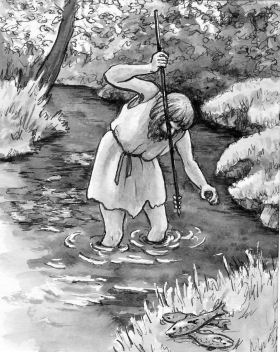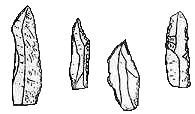

|
The Mesolithic settlers to this region were hunter gatherers, and would have led a nomadic lifestyle, with no permanent settlements, but would have moved around in small groups, probably living in either very simple tents made from animal skins, or in primitive huts made by tying together sticks to make a wooden dome shaped frame, then covering the frame with fur or turf to protect the inhabitants from the weather. They would spend most of their time engaged in gathering enough food for survival, and would have had to develop a range of tools to suit this new environment. This they achieved by hunting with arrows and spears with multiple barbs (microliths) embedded in their shafts, thereby reducing the risk of hunting failure should one barb break. Not only would the remaining ones perform its function, but replacements could be knapped from a small blade-core.
They would have lived by hunting animals such as wild boar, hare, and deer, and fishing in the richly stocked rivers and sea, and the forests would have provided them with a bountiful harvest of edible fruit, nuts and berries during the during the spring and summer months. In this way the people would be tied very closely to the seasons of the year and would have travelled to new areas as different types of food became available. Their tools would have been made using flint, bone and wood and they probably made nets from fibres, and bags from animal skins. Animal skins would also be used for clothing and dyes would have been made from vegetables, plants and the soil. Being nomadic they carried very little with them, but their stone tools were of great importance. Although they also used wood, bone, and antler, it is usually just stone that has survived. There are no natural deposits of flint or chert near Witheridge, though some chert is to be found to the east of Tiverton, but more substantial amounts occur in the Vale of Taunton. Therefore all the stone for tools had to be brought in from elsewhere, and so would have been highly prized. As the Mesolithic period developed chert was largely replaced by the more easily worked flint.
Around 4,000BC growing numbers of the Mesolithic bands left their precarious nomadic way of life and began to establish permanent settlements. First, areas in the forest had to be cleared, and trees would be felled using flint axes. A blade of just such an axe, made of a fine, pinkish flint has been found near Rackleigh, Worlington. It measured about 5ins long, was tapered, and had a cutting edge 3ins wide, and would have been fixed into a wooden handle. It may seem strange, but practical experiments have shown that very smooth, highly polished axes, like the Rackleigh example, are more efficient than rougher examples. Once clearings had been made, wild animals such as cattle, sheep and pigs would have been attracted by the grass that grew there and, over hundreds of years, became domesticated and the clearings could be enclosed by hedgebanks, fences or ditches. Another possibility once clearings had been established was to grow cereals, a practice which began in the Middle East and spread to Britain at this time. Thus Mesolithic people adapted by making their tools more reliable, living by hunting, fishing and gathering edible plants, and also began to learn how to domesticate animals and plants. Slowly fields began to spread out from the original settlements, and although their extent and remains of dwellings are often not visible from the ground, archaeologists can sometimes spot them from the air as crop marks. Ditches and pits that have been filled in still retain moisture and show up as greener and more luxuriant growth in crops or grass. On the other hand, buried stone features hold less moisture than the surrounding ground, so show up as paler marks, and often as parch marks in the summer. Aerial photography has revealed a few such sites around Witheridge which may be from this period. There are signs of enclosures near Woodington and Stourton Barton (Thelbridge), as well as at North Coombe (Templeton), although none of the sites have been investigated on the ground, so their dating cannot be confirmed. Previous Last Edited 03/07/2006 Copyright © 2000-2006 Witheridge Unless otherwise indicated on the page in question, the photographic images reproduced on this site belong to the Witheridge Archives, and, as such may not be reproduced for commercial purposes without written permission. However, you are welcome to use any of the photographs belonging to the archive for personal and/or non-commercial use. Any material shown as not being owned by the archive may not be reproduced in any form without first receiving written permission from the owner of the material in question. The copyright for the illustration of the Stone Age Hunter belongs to Witheridge Artist and Illustrator Jenny Bidgood. That of the collection of Flints is reproduced Courtesy of Devon County Council. |



